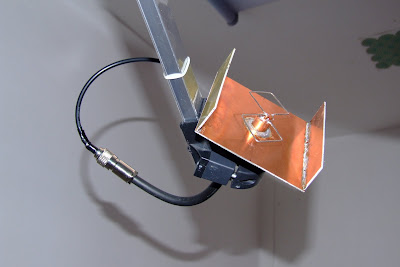Returning to the WiFi topic, here is the new antenna development that I had promissed in the early post, once the dual "cantenna" design was finished.
The dual cantenna is quite efficient, as I realized by connecting it to reasonably distant access points (in excess of 200 meters, with many obstacles between, including houses). By verifying the antenna efficiency was the expected, I assumed that in better conditions the range could be far greater, by establishing a link between two antennas of this type or other type of optimal configurations.
However, I knew I could push it a little further, so I decided to buy a 12 euro 45 cm dish from a regular satellite TV system, and the materials to build a biquad feed. I installed the dish on top of the tripod used for the cantennas, and attached the biquad feed (built according to
these instructions) to it:







